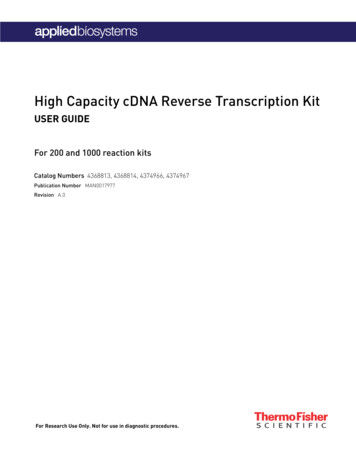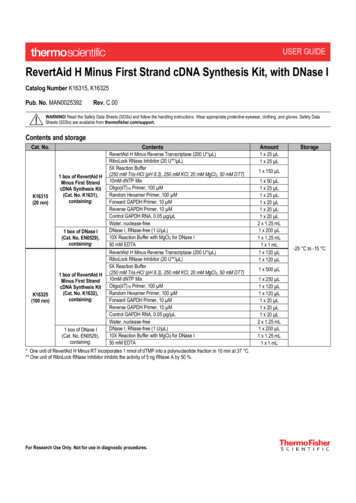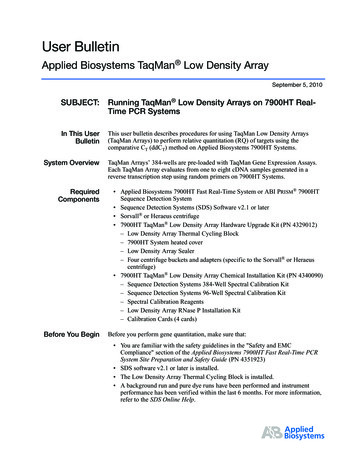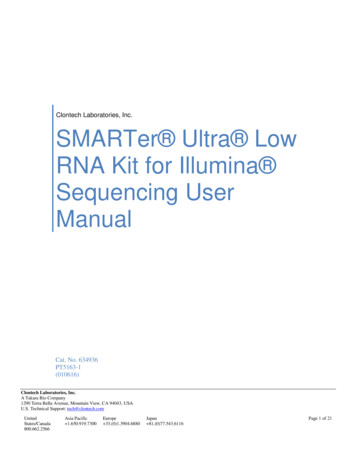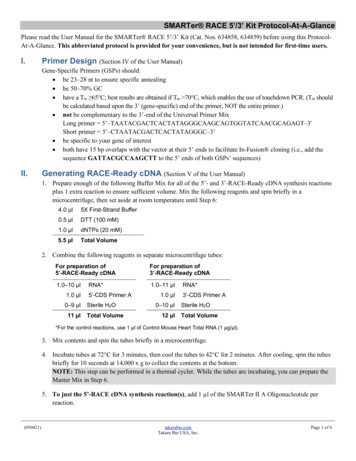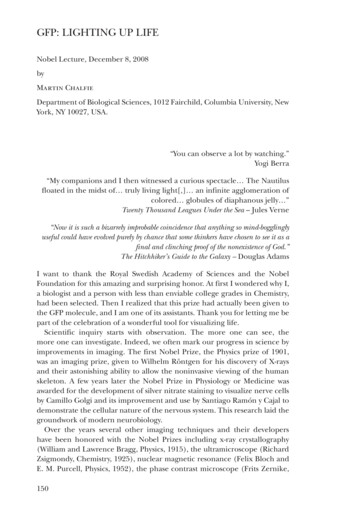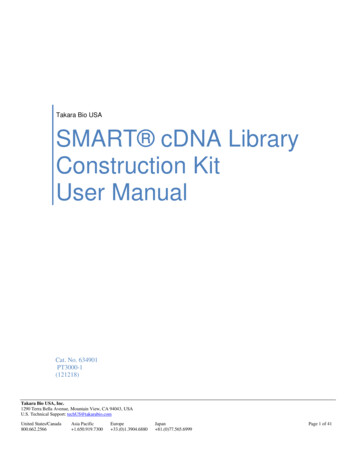
Transcription
Takara Bio USASMART cDNA LibraryConstruction KitUser ManualCat. No. 634901PT3000-1(121218)Takara Bio USA, Inc.1290 Terra Bella Avenue, Mountain View, CA 94043, USAU.S. Technical Support: techUS@takarabio.comUnited States/Canada800.662.2566Asia Pacific 1.650.919.7300Europe 33.(0)1.3904.6880Japan 81.(0)77.565.6999Page 1 of 41
SMART cDNA Library Construction Kit User ManualTable of ContentsI.Introduction . 3II.List of Components . 7III.Additional Materials Required . 9IV.General Considerations . 11V.SMART cDNA Synthesis by LD PCR or Primer Extension . 14A.General Considerations for cDNA Synthesis . 14B.Protocol: First Strand cDNA Synthesis. 16C.Protocol: ds cDNA Synthesis by LD PCR . 17D.Protocol: ds cDNA Synthesis by Primer Extension . 19E.Protocol: Proteinase K Digestion . 22F.Protocol: SfiI digestion . 22G.Protocol: cDNA Size Fractionation by CHROMA SPIN-400 . 23VI.SMART cDNA Library Protocols . 25A.Protocol: Ligation of cDNA to λTriplEx2 Vector . 25B.Protocol: Bacterial Culture Plating . 26C.Protocol: Titering the Unamplified Library . 27D.Protocol: Determining the Percentage of Recombinant Clones . 28E.Protocol: Library Amplification. 29F.Protocol: Titering the Amplified Library . 30VII.Troubleshooting Guide . 32VIII.References . 37Appendix A. Converting λTriplEx2 to pTriplEx2 . 38Table of FiguresFigure 1. Flow chart of the SMART cDNA Library Construction Kit protocols . 4Figure 2. Comparison of the SfiI (A & B) recognition sequences. . 6Figure 3. Generation of polypeptides from all three reading frames in a single recombinant λTriplEx2 clone . 6Figure 4. Guide to using the SMART cDNA Library Construction Kit protocols . 13Figure 5. Typical results: ds cDNA synthesized using the SMART control reagents and LD PCR protocol . 19Figure 6. Typical results: ds cDNA synthesized using the SMART control reagents and primer extension protocol. . 21Figure 7. Guide to troubleshooting SMART cDNA synthesis . 31Figure 8. Conversion of a recombinant λTriplEx2 to the corresponding pTriplEx2 . 39Figure 9. Restriction map of λTriplEx2 . 40(121218)takarabio.comTakara Bio USA, Inc.Page 2 of 41
SMART cDNA Library Construction Kit User ManualTable of TablesTable 1. Bacterial Host Strain Genotypes . 8Table 2. Host Strain Applications & Media Additives . 8Table 3. Differences Between the LD-PCR and Primer Extension Protocols . 14Table 4. Relationship Between Amount of RNA Starting Material and Optimal Number of Thermal Cycles . 17Table 5. Ligations Using Three Different Ratios of cDNA to Phage Vector. . 25Table 6. Plating Dilutions for Titering an Amplified Library . 30Table 7. Troubleshooting Guide . 32I.IntroductionA. SummaryThe SMART cDNA Library Construction Kit (Cat. No. 634901) provides a method for producing high-quality,full-length cDNA libraries from nanograms of total or poly A RNA. The kit offers a choice of two differentmethods for synthesizing the cDNA, depending on your starting material—and a single method for constructinglibraries from cDNA generated using either synthesis method. The cDNA synthesis methods include: cDNA Synthesis by Long Distance (LD) PCR: A novel, PCR-based method for researchers limited bytheir starting material (i.e., 50 ng of total RNA; see Section I.D). cDNA Synthesis by Primer Extension: A more traditional method for researchers with abundantamounts of starting material (i.e., 1 µg or more poly A RNA; See Section I.E).Both methods utilize the proprietary SMART IV (Switching Mechanism At 5' end of RNA Template)Oligonucleotide in the first-strand synthesis to generate high yields of full-length, double-stranded (ds) cDNA(Figure 1).B. SMART Enriches for Full-Length cDNA with Complete 5' EndsAll commonly used cDNA synthesis methods rely on the ability of reverse transcriptase (RT) to transcribe mRNAinto single-stranded (ss) DNA in the first-strand reaction. In some cases, RT terminates before transcribing thecomplete mRNA sequence. This is particularly true for long mRNAs, especially if the first-strand synthesis isprimed with oligo(dT) primers only or if the mRNA contains abundant secondary structures. In addition,conventional cDNA cloning procedures use T4 DNA polymerase to generate blunt cDNA ends after the secondstrand synthesis and adaptor ligation steps. As a result, under-represented 5' ends of genes in cDNA populationstend to be 5–30 nucleotides shorter than the original mRNA (D’Allessio, 1988). The SMART protocols are designed to preferentially enrich for full-length cDNAs, while eliminatingblunt end adaptor ligations. SMART libraries are proven to contain a higher percentage of full-length clones than librariesconstructed by conventional methods or other full-length cDNA synthesis protocols (Okayama & Berg,1982; Kato et al., 1994). Thus, clones isolated from SMART cDNA libraries contain sequencescorresponding to the complete 5' untranslated region of the mRNA (ibid.).C. SMART Preserves the Complete 5' mRNA SequenceLibraries made with SMART cDNA can facilitate preliminary mapping of transcription start sites (FromontRacine, 1993) due to the high percentage of full-length clones. However, SMART cDNA libraries may not besuitable for immunoscreening for certain proteins; as in some cases, 5' untranslated regions (UTRs) may containstop codons in frame with the initiating translation start site in the expression vector.(121218)takarabio.comTakara Bio USA, Inc.Page 3 of 41
SMART cDNA Library Construction Kit User ManualFigure 1. Flow chart of the SMART cDNA Library Construction Kit protocols. The right side of the flow chart shows the fate of incompletetranscripts caused by RNA degradation or premature termination of reverse transcription.(121218)takarabio.comTakara Bio USA, Inc.Page 4 of 41
SMART cDNA Library Construction Kit User ManualD. cDNA Synthesis by Long-Distance PCRIn Section V.C, long-distance PCR (LD PCR; Barnes et al., 1994, Cheng et al., 1994) is used to generate a fulllength ds cDNA after first strand cDNA synthesis in Section V.B (Figure 1). This protocol is ideal for researcherswho are limited by the amount of their available RNA starting material (i.e., 50 ng of total RNA).Protocol Summary1. A modified oligo(dT) primer (CDS III/3' PCR Primer) primes the first-strand synthesis reaction,and the SMART IV Oligo serves as an acceptor template for template switching. When the RT reaches the 5' end, the enzyme’s terminal transferase activity adds a few additionalnucleotides, primarily deoxycytidine, to the 3' end of the cDNA. The SMART IV Oligo, which has an oligo (G) sequence at its 3' end, base-pairs with thedeoxycytidine stretch, creating an extended template. RT then switches templates and continuesreplicating to the end of the oligonucleotide.2. The resulting full-length ss cDNA contains the complete 5' end of the mRNA, as well as the sequencecomplementary to the SMART IV Oligo, which then serves as a universal priming site (SMART anchor)in the subsequent amplification by LD PCR (Chenchik et al., 1998) to generate a full-length ds cDNA. Only those ss cDNAs having a SMART anchor sequence at the 5' end can serve as a template andcan be exponentially amplified. Incomplete cDNAs and cDNA transcribed from poly A– RNAwill lack the SMART anchor and will not be amplified. Thus, contamination by genomic DNAand nonpolyadenylated RNA is eliminated. This selective amplification allows you to construct a cDNA library using nanogram amounts ofeither total RNA or poly A RNA with a high percentage of full-length clones.E. cDNA Synthesis by Primer ExtensionIn Section V.D, primer extension (Green & Sambrook, 2012), is used to generate a full-length ds cDNA after firststrand cDNA synthesis in Section V.B (Figure 1). This protocol is ideal for researchers who are not limited bytheir starting material (i.e., 1 μg or more of poly A RNA).Protocol Summary1. Using a procedure similar to the first-strand cDNA synthesis summarized in Section I.D, Step 1, the CDSIII/3' Primer is used to prime the first-strand reaction, and the SMART IV Oligo serves as a short,extended template at the 5' end of the mRNA.2.After first-strand cDNA synthesis, the primer-extension step generates full-length, ds cDNA.F. Optimized Reagents and ConditionsThe SMART kit incorporates carefully optimized reagents and conditions that improve the efficiency of all libraryconstruction steps. (121218)A specially formulated first-strand buffer and modified lock-docking oligo(dT) primers (Borson etal., 1992) optimize the efficiency of first-strand synthesis. Lock-docking primers are designed to annealto the junction of the poly A tail and the encoded transcript. This increases the efficiency of cDNAsynthesis by eliminating unnecessary reverse transcription of long stretches of poly A.takarabio.comTakara Bio USA, Inc.Page 5 of 41
SMART cDNA Library Construction Kit User Manual Advantage 2 PCR Kits (Cat. Nos. 639206 & 639207; not supplied—order separately) are stronglyrecommended for PCR amplification. Incorporation of asymmetrical SfiI (A & B) restriction enzyme sites (Figure 2) at the 5' and 3'cDNA ends, respectively (Figure 1) allows directional cloning into λTriplEx2 Vector. After digestionwith SfiI and size fractionation using CHROMA SPIN Columns, SMART cDNA is ready for ligationinto the SfiI-digested λTriplEx2 Vector. λTriplEx2, which contains the asymmetrical SfiI sites (A & B) inthe MCS, eliminates adaptor ligation, and facilitates directional cloning. Furthermore, SfiI sites areextremely rare in mammalian DNA; therefore, all SMART cDNAs remain intact after SfiI digestion.Methylation steps are eliminated, allowing valuable internal restriction sites to be preserved. Typicalresults of cDNA synthesis, using the Mouse Liver Poly A RNA provided, are shown for LD-PCR at theend of Section V.C, and for primer extension at the end of Section V.D.Figure 2. Comparison of the SfiI (A & B) recognition sequences.G. Benefits of λ TriplEx2 VectorClontech’s λTriplEx2 phagemid vector offers the following advantages for cDNA cloning: High-titer libraries, blue/white screening for recombinants, regulated expression of cloned inserts, andease of converting clones from phage to a plasmid vector via Cre-lox-mediated subcloning. Lambda arms that can accept inserts of up to 13 kb, making this vector more suitable for large-insertlibraries. Every cDNA inserted into the MCS of λTriplEx2 is expressed in all three reading frames (Figure 3).Figure 3. Generation of polypeptides from all three reading frames in a single recombinant λTriplEx2 clone. λTriplEx2 contains twotranslation start sites (i.e., two sets of ribosome-binding sites and ATG start codons) in different reading frames and a slip site (a stretch ofdTs) that can cause ribosomes to shift frames between the regulated lac promoter and the MCS. RNA polymerase may also slip duringtranscription of the (dT)13 region. By the time the ribosomes begin translating the insert, roughly one-third will be in each of the threereading frames.(121218)takarabio.comTakara Bio USA, Inc.Page 6 of 41
SMART cDNA Library Construction Kit User ManualII.List of ComponentsStore CHROMA SPIN Columns, 1X Column Buffer, and Deionized H 2O at room temperature. Store BM25.8 and XL1Blue E. coli host strains, Control RNA, and SMART IV Oligonucleotide at –70 C. Store all other reagents at –20 C.A. SMART cDNA Library Construction Kit ContentsFirst-Strand SynthesisSMART IV Oligonucleotide (12 μM) 10 S III/3' PCR Primer (12 μM) 25 N A, G, C, or T; N–1 A, G, or C)SMARTScribe MMLV Reverse Transcriptase (100 units/μl) 10 µl5X First-Strand Buffer 30 µl 250 mMTris (pH 8.3) 30 mMMgCl2 375 mMKClDTT(dithiothreitol;20 mM) 20 µl 5 µlControl Poly A RNA (Mouse Liver; 1.0 μg/μl)cDNA Amplification5' PCR Primer (12 μM) 20 µl5'-AAGCAGTGGTATCAACGCAGAGT-3'Digestion of PCR EnzymesProteinase K ( 600 mAnsonU/ml)) 20 µlSfiI Digestion 80 µl 80 µl 10 µlSfiI Enzyme (20 units/μl)10X SfiI Buffer100X BSAcDNA PurificationCHROMA SPIN-400 Columns 101X Fractionation Column Buffer 30 mlVector LigationλTriplEx2 (SfiI A & B-digested arms) (0.5 μg/μl) 30 µlT4 DNA Ligase (400 units/μl) 20 µl10X DNA Ligation Buffer 30 µl 500 mMTris-HCl (pH 7.8) 100 mMMgCl2 100 mMDTT 0.5 mg/ml BSAATP (10 mM) 20 µl 5 µlHost Cells 0.5 ml 0.5 ml 60 µl 60 µl(121218)Control Insert (SfiI A & B) (50 ng/μl)E. coli BM25.8 (in 25% glycerol, genotype in Table 1)E. coli XL1-Blue (in 25% glycerol, genotype in Table 1)5'-Sequencing Primer (20 μM)3'-Sequencing Primer (20 μM)takarabio.comTakara Bio USA, Inc.Page 7 of 41
SMART cDNA Library Construction Kit User ManualGeneral ReagentsdNTP mix (dATP, dCTP, dGTP, dTTP, 10 mM each) 20 µlSodium Acetate (3 M; pH 4.8) 200 µlSodium Hydroxide (25 mM) 20 µlGlycogen (20 μg/μl) 60 µlDeionized H2O (Milli-Q-filtered, not DEPC-treated) 5 µlB. Host Strain InformationTable 1. Bacterial Host Strain GenotypesStrainXL1-BlueGenotypeendA1, gyrA96, hsdR17, lac–, recA1, relA1, supE44, thi-1,[F' lacI qZ ΔM15, proAB, Tn10]Note: Tn10 confers resistance to tetracycline.Reference: Wood et al., 1985BM25.8supE44, thi Δ(lac–proAB) [F’ traD36, proAB , lacIqZ ΔM15]λimm434 (kanR)P1 (camR) hsdR (rk12– mk12–)Note: BM25.8 is lysogenic for phages λ and P1 and is used for automatic subcloning.Reference: Palazzolo et al., 1990Table 2. Host Strain Applications & Media AdditivesHost StrainXL1-BlueStock PlateLB/tet(15 μg/ml)BM25.8LB/kan (50 μg/ml)/cam (34 μg/ml) Application(s)Library plating & screeningBlue/white (β-galactosidase) screeningRegulated expression of cloned genesCre-lox-mediated excision of pTriplEx2 from λTriplEx2(see Appendix A and Figure 9)Media Additives Recommended for Lambda Phage TransductionsFor λ phage transductions, including plaque titering, library plating, and screening, use the following mediaadditives for optimal adsorption of phage to bacteria:(121218) 10 mM MgSO4 in LB agar and LB top agar 10 mM MgSO4 and 0.2% maltose in LB broth when growing overnight bacterial cultures for λ phagetransductions. Before using XL1-Blue overnight cultures in phage transductions, centrifuge the cells, pour off thesupernatant, and resuspend the pellet in 10 mM MgSO4 (in H2O). Before using BM25.8 overnight cultures in phage transductions, add MgCl2 to a final concentration of10 mM. If the bacterial strains are always maintained on stock plates containing the appropriate antibiotic, there isno need to add antibiotics to the LB broth when growing overnight cultures.takarabio.comTakara Bio USA, Inc.Page 8 of 41
SMART cDNA Library Construction Kit User ManualIII.Additional Materials RequiredThe following reagents are required but not supplied.Store all reagents and solutions at room temperature (20–22 C) unless specified otherwise.For First-Strand cDNA Synthesis & SMART PCR ds cDNA Synthesis Advantage 2 PCR Kit (Cat. Nos. 639206 & 639207) Sterile, 0.5 ml microcentrifuge tubes Poly A or total RNA Mineral oil (We recommend Sigma Cat. No. M-3516.) DNA size markers (1 kb DNA Ladder, Takara Bio Cat. No. 3412B) 1.1% Agarose/EtBr gel (containing 0.1 μg/ml ethidium bromide)For Proteinase K Digestion Sterile, 0.5 ml microcentrifuge tubes 95% ethanol 80% ethanolFor cDNA Size Fractionation 1.5 ml sterile microcentrifuge tubes Ring-stand with small clamp (for holding column) 1.1% agarose/EtBr gel (0.1 μg/ml ethidium bromide) 95% ethanol (–20 C) 1% xylene cyanolFor λ Phage Packaging λ phage packaging extract: Several are commercially available. Choose a packaging system that will give youat least 1 x 109 pfu/μg of DNA (e.g., MaxPlax Lambda Packaging Extracts, Epicentre Cat. No. MP5120)For PCR Insert Screening [optional] λTriplEx LD-Insert Screening Amplimer SetsFor Routine Plating and Culture of E. coli(121218) Kanamycin stock solution (25 mg/ml in H2O; 500X); Store at –20 C Tetracycline stock solution (15 mg/ml in H2O; 1,000X); Store at –20 C Chloramphenicol stock solution (34 mg/ml in 100% ethanol; 1,000X). Store at –20 C. LB broth/LB agar LB agar plates LB/tet agar plates LB/kan/cam agar platestakarabio.comTakara Bio USA, Inc.Page 9 of 41
SMART cDNA Library Construction Kit User ManualFor transduction and titering of λ phage in E. coliWhen preparing media for phage transductions or plaque titering, use recipes containing 10 mM MgSO4 for optimaladsorption of phage to bacteria. For the same reason, add 0.2% maltose to the LB broth when growing overnightbacterial cultures for transduction/titering. MgSO4 (1 M stock solution)Dissolve 24.65 g of MgSO4 7H2O in 100 ml of deionized H2O. Filter sterilize. 20% Maltose stock solutionDissolve 20 g of maltose in 80 ml of deionized H2O; bring volume up to 100 ml. Filter sterilize and store at4 C. LB/MgSO4 agar platesTo one liter of LB broth, add:- 10 ml 1 M MgSO4 (10 mM final concentration)- 15 g agarAutoclave. Pour plates and store at 4 C. LB/MgSO4 brothTo one liter of LB broth, add 10 ml 1 M MgSO4 (10 mM final concentration). Autoclave. LB/MgSO4/maltose brothPrepare 1 L LB/MgSO4 broth as described above. After autoclaving, cool to 50 C before adding maltose to afinal concentration of 0.2%. (10 ml of 20% maltose stock solution.) LB/MgSO4 soft top agarTo one liter of LB broth, add:- 10 ml 1 M MgSO4 (10 mM final concentration)- 7.2 g agarAutoclave and store at 4 C. 10X Lambda dilution bufferNaClMgSO4 7H2OTris-HCI (pH 7.5)Final Conc.1.0 M0.1 M0.35 MTo prepare 1 L of solution58.3 g24.65 g350.0 ml of 1 MAdd H2O to a final volume of 1 L. Autoclave and store at 4 C. 1X Lambda dilution bufferCombine:-100 ml 10X Lambda dilution buffer5 ml 2% Gelatin (0.01% final concentration)Add H2O to a final volume of 1 L. Autoclave and store at 4 C.NOTE: The 0.01% gelatin in the 1X lambda dilution buffer stabilizes the library titer for long-term storage.Gelatin addition is optional when diluting the phage for immediate titering.(121218)takarabio.comTakara Bio USA, Inc.Page 10 of 41
SMART cDNA Library Construction Kit User ManualFor amplifying a λ library LB/MgSO4 plates LB/MgSO4 soft top agar 50 ml polypropylene, sterile screw-cap tubes ChloroformBlue/white screening in E. coli (i.e., β-galactosidase) IPTG (100 mM in H2O)Isopropyl β-D-thiogalactopyranoside. Filter sterilize. Store at 4 C. X-Gal (100 mM)Dissolve in dimethyformamide (DMF). Store at –20 C.Long-term library storage IV.100% Dimethylsulfoxide (DMSO)100% GlycerolGeneral ConsiderationsA. Good Laboratory Practices1. Wear gloves throughout the procedure to protect your RNA and cDNA samples from degradation bynucleases.2. When resuspending pellets or mixing reactions, gently pipet the solution up and down or tap the bottomof the tube. Spin tube briefly to bring contents to the bottom of the tube. Do not vortex samples whenresuspending pellets; vortexing may cause shearing of your cDNA.3. Perform all reactions on ice, unless otherwise indicated.4. Add enzymes to reaction mixtures last. Make sure that the enzyme is thoroughly blended into the reactionmixture by gently pipetting the mixture up and down.5. Do not increase the size (volume) of any of the reactions. All components have been optimized for thevolumes specified.6. Ethidium bromide is a carcinogen. Use appropriate precautions in handling and disposing this reagent.For more information, see Green & Sambrook (2012). Several EtBr disposable cartridges are alsoavailable, such as Clontech’s BondEx Ethidium Bromide Detoxification Cartridge.7. Phenol is a corrosive. Always wear gloves and protective clothing when handling solutions containingthis reagent. If possible, handle solutions containing phenol and/or chloroform under a chemical fumehood.(121218)takarabio.comTakara Bio USA, Inc.Page 11 of 41
SMART cDNA Library Construction Kit User ManualB. Preparation and Handling of Total and Poly A RNA1. Recommended PrecautionsTo avoid contamination and degradation of RNA (and to minimize the presence of RNases: Wear gloves. Use freshly deionized (e.g., Milli-Q-grade) H2O, untreated with DEPC (diethyl pyrocarbonate). Rinse all glassware with 0.5 N NaOH, followed by deionized H2O. Then bake the glassware at160–180 C for 4–9 hr. Use only single-use plastic pipettes and pipette tips with RNA. Avoid using autoclaved H2O because recycled steam in some autoclaves can introducecontaminants that may interfere with PCR.2. RNA isolationMany procedures are available for the isolation of total RNA and poly A RNA (Chomczynski & Sacchi,1987; Farrell, 1993; Green & Sambrook., 2012). Clontech offers several kits for the isolation of totalRNA and subsequent isolation of poly A RNA.3. RNA analysisMethods for Assessing Total RNA Integritya. Formaldehyde agarose gel visualization with Ethidium Bromide (EtBr):The integrity of total RNA can be visually assessed by the ratio of 28S:18S RNA on a denaturingformaldehyde agarose gel by staining with EtBr. The theoretical 28S:18S ratio for eukaryoticRNA is approximately 2:1. For mammalian total RNA, you should observe two bright bands atapproximately 4.5 and 1.9 kb; these bands represent 28S and 18S ribosomal RNA. The ratio ofintensities of these bands should be 1.5–2.5:1. For more information, see Green & Sambrook(2012).b. Formaldehyde agarose gel visualization with SYBR Green or SYBR Gold:One drawback of visualizing RNA with Ethidium Bromide is the amount of sample required.Alternative dyes such as SYBR Green II or SYBR Gold (Invitrogen, CA) allow you to detect aslittle as 1 or 2 ng of RNA (using SYBR Gold and SYBR Green II, respectively). These dyes areespecially useful if you have a limited amount of RNA.c. Detection with the Agilent 2100 BioAnalyzer (Agilent Technologies, CA):This microfluidics-based technology, which provides an alternative to traditional gel-basedanalysis, requires only 10 ng of RNA per analysis. In addition to assessing RNA quality, thisautomated system provides a good estimate of RNA concentration.Methods for Assessing mRNA IntegrityAll of the above methods can be used to assess mRNA quality. However, since mRNA does not containstrong ribosomal bands, this assessment will be somewhat subjective. Typically, mRNA appears as asmear between 0.5 kb –6 kb, with an area of higher intensity around 1.5 and 2 kb. This size distributionmay be tissue or species-specific. An average mRNA size lower than 1.5 kb could indicate degradation.(121218)takarabio.comTakara Bio USA, Inc.Page 12 of 41
SMART cDNA Library Construction Kit User ManualFigure 4. Guide to using the SMART cDNA Library Construction Kit protocols. Be sure to choose the appropriate protocol for your application.Refer to Figure 7 and Section VII for troubleshooting tips.(121218)takarabio.comTakara Bio USA, Inc.Page 13 of 41
SMART cDNA Library Construction Kit User ManualV.SMART cDNA Synthesis by LD PCR or Primer ExtensionThis section describes how to synthesize double-stranded SMART cDNA for library construction (see Figure 4) usingeither LD (long distance) PCR or primer extension: General guidelines are provided for both methods (Section V.A). First strand cDNA synthesis is presented in a single protocol for both methods (Section V.B), which differonly as described in Steps 1 & 9. Second strand cDNA synthesis (to yield a double-stranded cDNA) is presented in separate protocols for LDPCR (Section V.C) and primer extension (Section V.D).NOTE: The differences between the first strand and ds cDNA synthesis protocols used for LD-PCR andprimer extension samples are summarized in Table 3 below. Proteinase K digestion (Section V.E), SfiI digestion (Section V.F), and cDNA size fractionation byCHROMA SPIN-400 (Section V.G) protocols are identical for both methods, as are the SMART cDNALibrary Protocols in Sections VI.A–F.Table 3. Differences Between the LD-PCR and Primer Extension ProtocolsProtocol StageFirst strandcDNA synthesisLD-PCR MethodSection V.B:Section V.B: Step 1. Starting material:- (121218) Poly A RNA (0.5 µg–2 µg)Step 9. After reaction is complete:Proceed to ds cDNA synthesis-Treat with sodium hydroxide-Proceed to ds cDNA synthesisSection V.C:Section V.D: Step 2. Use 2 µl of the first strandcDNA synthesized in Section V.B Step 2. Use 11 µl of the first strandcDNA synthesized in Section V.B Step 5. LD PCR reaction:- Use a thermal cycling programspecific for LD-PCR Step 5. Primer extension reaction:- Use a thermal cycling programspecific for primer extension-Agarose/EtBr gelanalysis of dscDNA)Step 1. Starting material:Total RNA (50 ng–2 µg) orpoly A RNA (25 ng–1 µg)Step 9. After reaction is complete:-ds cDNAsynthesisPrimer Extension Method-Amplify using 18–26 cycles,depending on the amount ofstarting materialAmplify using 3 cyclesSection V.C:Section V.D: Step 6. Expect a 0.1–4 kb smear, withsome distinct bands from abundantmRNAstakarabio.comTakara Bio USA, Inc.Step 6. Expect a 0.1–9 kb smear, withsome distinct bands from abundantmRNAsPage 14 of 41
SMART cDNA Library Construction Kit User ManualA.General Considerations for cDNA Synthesis1.Starting Material Amounts LD PCR protocol (minimum amount): 50 ng of total RNA or 25 ng of poly A RNAIn general, the more RNA you start with, the fewer PCR cycles will be required for thesecond-strand synthesis (see Table 4 in Section V.C). Fewer thermal cycles are less likely togenerate nonspecific PCR products, and thus are best for optimal cDNA and library quality.If your RNA sample is not limiting, use the higher starting amounts of RNA shown in thetable (up to 2 µg). Primer extension protocol (optimal amount): 1 μg of poly A RNA (0.5 μg–2.0 μg)The optimal amount of starting material for cDNA synthesis is about 1 μg of poly A RNA(0.5 μg–2.0 μg). Reduced cloning efficiency will occur if you use less than 0.5 μg or greaterthan 2.0 μg of poly A RNA.2.3.(121218)Positive ControlWe strongly recommend that you perform a positive control cDNA synthesis with the mouse liverpoly A RNA provided, in parallel with your experimental cDNA synthesis, using either the LD PCRor the primer extension protocol. To identify problems at different s
1. Using a procedure similar to the first-strand cDNA synthesis summarized in Section I.D, Step 1, the CDS III/3' Primer is used to prime the first-strand reaction, and the SMART IV Oligo serves as a short, extended template at the 5' end of the mRNA. 2. After first-strand cDNA synthesis, the primer-extension step generates full-length, ds cDNA.
